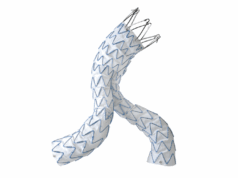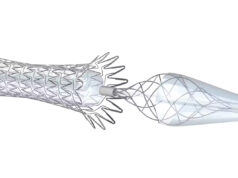
Peter Schneider (University of California San Francisco, San Francisco, USA) recently presented 36-month data from Surmodics’ TRANSCEND clinical trial at the VEITHsymposium 2023 (14–18 November, New York, USA).
The TRANSCEND trial is a prospective, multicentre, single-blind randomised controlled trial to assess the safety and efficacy of the SurVeil drug coated balloon (DCB; Surmodics) versus the IN.PACT Admiral DCB (Medtronic) for treatment of superficial femoral and proximal popliteal artery lesions. A total of 446 patients were randomised to either the low-dose paclitaxel (2.0µg/mm2) SurVeil DCB (n = 222) or the high-dose (3.5µg/mm2) paclitaxel IN.PACT Admiral DCB (n=224) at 65 sites in the USA, Australia, Austria, Belgium, Czech Republic, Germany, Italy, Latvia and New Zealand.
The primary efficacy endpoint is 12-month primary patency, defined as freedom from binary restenosis or clinically driven target lesion revascularisation (CD-TLR). Primary patency was comparable between the SurVeil DCB and IN.PACT Admiral (82.2% vs. 85.9%). The primary safety endpoint is freedom from device- or procedure-related death within 30 days and above-ankle amputation or CD-TLR within 12 months, which also demonstrated comparable outcomes between SurVeil DCB and IN.PACT Admiral DCB (91.8% vs. 89.9%). Non-inferiority was tested using a multiple imputation approach at one-sided alpha 0.025.
Data demonstrate the SurVeil DCB is non-inferior to the IN.PACT Admiral DCB with regards to both safety and efficacy while delivering a substantially lower drug dose, a Surmodics press release reports. Both the SurVeil and IN.PACT Admiral DCBs utilise coatings with the antiproliferative drug paclitaxel. However, the IN.PACT Admiral DCB has a 75% higher drug load of paclitaxel (3.5μg/mm2) than the SurVeil DCB, which has a 2.0μg/mm² drug load.
Patient outcomes are being collected at one, siz, 12, 24, 36, 48, and 60 months. Intermediate-term (36-month) secondary outcomes included CD-TLR, major target limb amputation (TLA), thrombosis at the target lesion, and historical major adverse events.
A total of 352/363 (96.97%) patients completed their 36-month visit.
Surmodics states that the SurVeil DCB, which previously demonstrated noninferior primary safety and effectiveness outcomes through 12 months with a lower paclitaxel dose, continues to demonstrate similar outcomes at intermediate-term follow-up of 36 months compared with the high-dose IN.PACT Admiral DCB in the treatment of patients with symptomatic peripheral arterial disease (PAD) caused by stenosis of the femoral and/or popliteal arteries. Results at 36 months for SurVeil versus IN.PACT Admiral were statistically comparable, including CD-TLR (20.3% vs. 19.5%; p=0.897), major TLA (0.0% vs. 0.5%; p=1), thrombosis at the target lesion (0.6% vs. 0.0%; p=0.475), and historical major adverse events (MAEs; 28.6% vs. 28.5%; p=1).
“The TRANSCEND 36-month data continue to demonstrate safe and effective performance of the SurVeil DCB. SurVeil DCB is a best-in-class, high-quality treatment option for our PAD patients utilising a next-generation surface coating with a lower dose of paclitaxel compared to IN.PACT Admiral DCB,” said Schneider.












